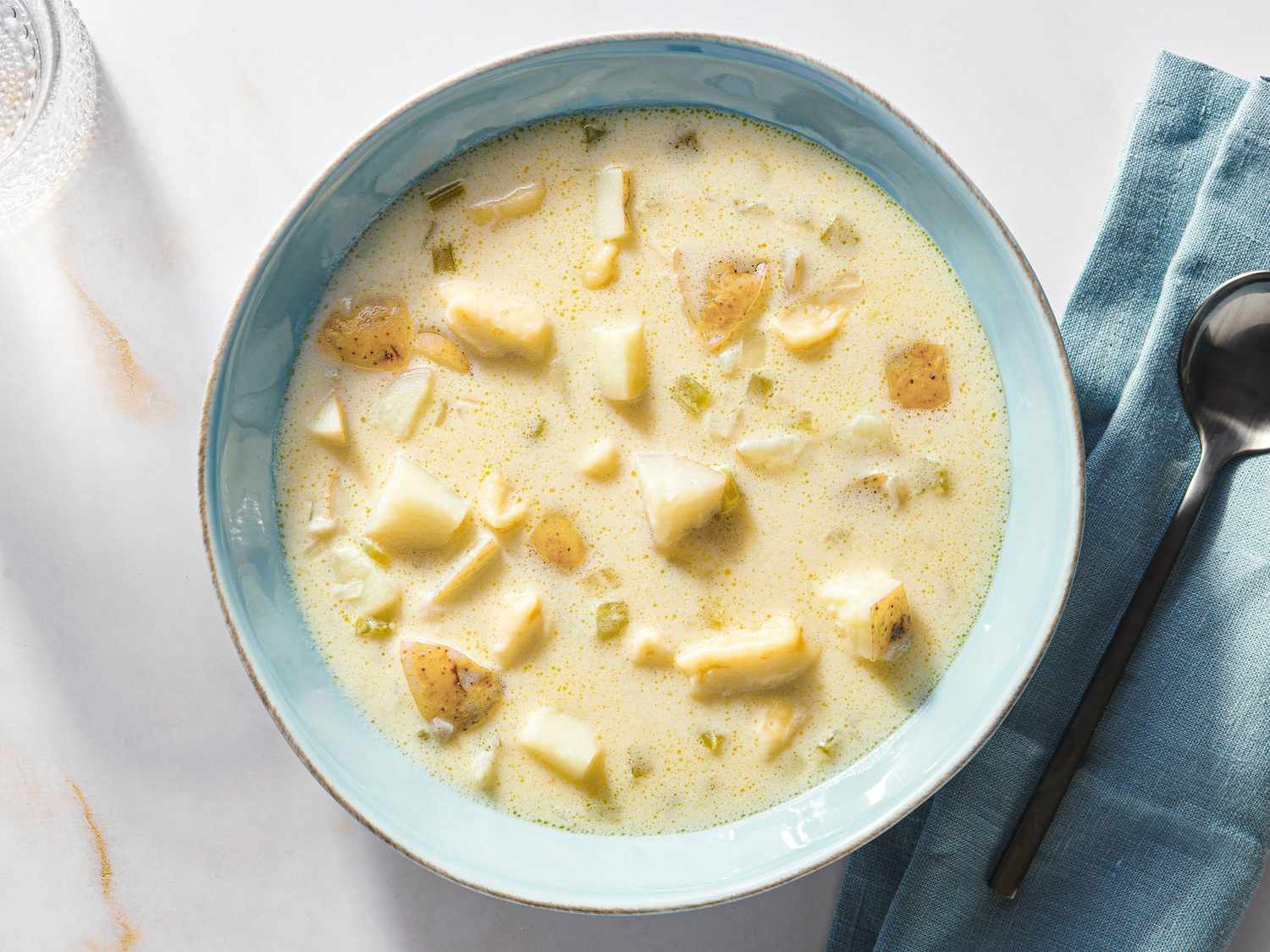The Science Behind the Perfect Knoephla Soup
Incorporating milk and baking powder into the dumpling mixture enhances their tenderness. Allowing the dough to rest briefly after mixing helps relax the gluten, making it easier to shape the dumplings. To achieve a luxurious finish without risking curdling, heavy cream is stirred into the soup off heat.
During a recent road trip through North Dakota, just fifteen minutes from Strasburg—home of Lawrence Welk—I found myself pulled over by law enforcement. Despite years of traveling across the Midwest without receiving a speeding ticket, I was clocked going 70 in a 65 zone.
The officer issued me a ticket but also shared his thoughts on knoephla—a cherished creamy dumpling soup with German roots that’s beloved in North Dakota—after asking about my visit to the state (which was primarily for its food). “My grandma used potato in her dumplings,” he mentioned. “There are various methods; not sure which one is correct.” He shrugged nonchalantly.
Indeed, there are numerous variations of this dish. While adding potato to knoephla is less common, most stories surrounding this soup involve someone’s grandmother and emphasize its comforting simplicity—typically featuring good chicken broth and handmade (never frozen!) dumplings.
Over two months, I indulged in countless bowls of knoephla soup while searching for my ideal recipe. I experimented with heavy cream and carbs galore while testing secret ingredients like miso, celery seed, and assorted herbs. Jeremy Kopp—the interim director at North Dakota State University’s Germans From Russia Heritage Collection—noted during our research that there’s often an urge to innovate traditional recipes: “Historically speaking, everyone had their own twist on things; however, when you strip it down to basics—it’s all quite similar.” Today’s cooks often seek ways to stand out: “If not for that uniqueness,” he mused, “why would anyone read my blog or cookbook?”
After all my culinary explorations aimed at innovation and distinction led me back to a classic knoephla recipe reminiscent of those found in community cookbooks I’ve collected over time (but refined for optimal results). This straightforward approach honors what this dish deserves—a warm introduction.
Crafting My Ideal Knoephla Soup
The version of knoephla soup I find most satisfying strikes a balance between comfort and richness; it has a texture akin to both rich chicken broth and béchamel sauce. Some variations lean towards gravy-like thickness—which can be delightful during winter—but too much can be overwhelming for regular consumption. Others resemble thinner soups like chicken-and-dumplings sans meat but lack that comforting depth associated with true knoephla soup. For this recipe, I opted for just enough roux to thicken it perfectly.
Adding russet potatoes cut into cubes enhances each spoonful with earthy flavor while providing substance as they soften within the broth. Chopped celery contributes savory complexity; research published in Journal of Agricultural and Food Chemistry highlights how volatile compounds present in celery amplify sweet and umami flavors—making it an excellent addition here! While carrots are commonly included by some cooks (and turmeric adds color), they’re absent from many traditional recipes—and part of what makes knoephla appealing is its simplicity akin to mac-and-cheese without unnecessary additions.
The Dumpling Component
Many North Dakotans liken these dumplings used in knoephla soup to spaetzle—a close relative—but they tend toward denser textures compared with fluffy Southern-style dumplings yet remain tender after simmering for twenty minutes within broth! Incorporating milk into your dough along with baking powder ensures soft yet slurpable results!
In this recipe format provided below—you’ll prepare your dumplings ahead so you can add them simultaneously into your bubbling pot! Many grandmas from North Dakota prefer snipping them directly using scissors—which works well too—but may lead slightly different cooking times since cutting multiple ropes takes time especially if you’re new at it! However once simmered together any texture differences become negligible!
Through extensive interviews combined with sampling various versions throughout Fargo—I’ve crafted an uncomplicated yet satisfying take on this beloved dish! As Robert Serr from Bismarck’s Little Cottage Café aptly stated: “You could complicate something as simple as knoephla until you don’t even recognize what you’re making anymore…or keep things straightforward using readily available ingredients yielding delicious outcomes.”
And that’s precisely how we should approach our cooking endeavors!
Knoephla Soup Recipe (North Dakota Cream-and-Dumpling)
Ingredients:
For Dumplings:
- 2 cups all-purpose flour
- 1 teaspoon kosher salt
- 1 teaspoon baking powder
- 2 large eggs
- 6 tablespoons whole milk (plus more if needed)
For Soup:
- 4 tablespoons unsalted butter
- 1 medium yellow onion (diced)
- 4 stalks celery (diced)
- 1 tablespoon kosher salt
- 1 teaspoon ground white pepper
- ¼ cup all-purpose flour
- 8 cups homemade or low-sodium chicken stock
- About five medium waxy yellow potatoes cut into cubes -1 cup heavy cream
Instructions:
Dumpling Preparation:
In one bowl whisk together flour,salt & baking powder then set aside.In another bowl mix eggs & milk until well blended.Pour wet mixture onto dry ingredients stirring until shaggy dough forms.Add additional milk gradually if necessary.Knead dough lightly before wrapping tightly letting rest at room temperature between thirty minutes up-to-an hour.Cut rested dough evenly then roll each piece thinly before slicing them right before adding them directly into simmering pot later on!
Soup Preparation:
While waiting prepare Dutch oven heating butter over medium-high heat.Add onions/celery seasoning accordingly.Sauté vegetables till softened (~5 mins) then sprinkle flour stirring constantly till no dry bits remain.Pour stock slowly scraping bottom loosening any stuck pieces.Bring mixture up-to-a gentle boil followed by adding cubed potatoes/dumplings allowing everything cook through (~15 mins).Finally stir-in cream adjusting seasoning per taste preferences before serving hot alongside crusty bread or crackers!
Storage Tips:
This delightful concoction keeps well refrigerated up-to-three days although note that leftover noodles will absorb liquid becoming softer over time which many consider enhancing flavors further upon reheating next day!

